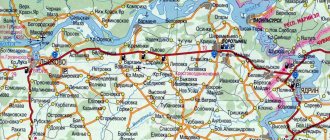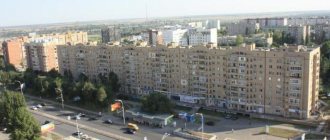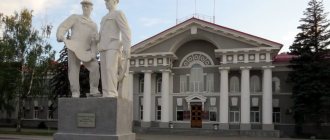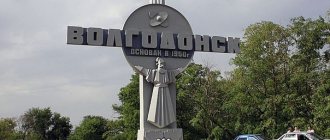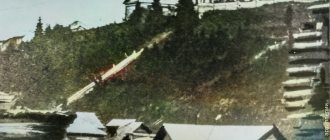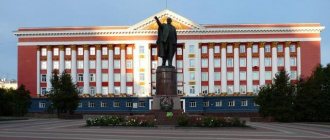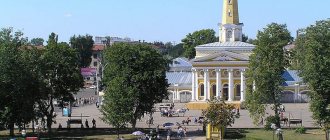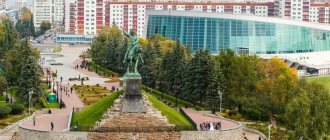General information and history of the city
Volgodonsk is a very young city; three generations of residents have not yet replaced it.
The city owes its appearance to a gigantic Soviet construction project - the digging of the Volgodonsk Canal, connecting two great Russian rivers - the Don and the Volga. Work began in 1949, thousands of workers arrived, and a settlement was organized to house them. The workers' settlement Novo-Solenovsky, intended after construction for the residence of workers servicing the Tsimlyansky hydroelectric complex, and in it in 1950 the industrial construction of multi-storey buildings began. This date became the founding day of Volgodonsk.
Volgodonsk in Soviet times
In 1958, a huge chemical plant was built, and the workers' settlement was given the title of city. In 1975, it was launched, and to improve the life of its workers, they began to build up the left bank of the Sukho-Solenovsky Bay of the Tsimlyansk Reservoir, the current New Town.
In 1977, it was decided to build a nuclear power plant in Volgodonsk. Work had begun, and the first building was almost completely erected when the explosion occurred at the Chernobyl nuclear power plant. Residents of the city, frightened by such a prospect from the use of nuclear energy, and even fueled by city politicians (who made a career out of it), organized pickets and rallies. As a result, in 1990, a decision was made to stop construction.
Embankment in Volgodonsk. Monument to Cossack General Ya.P. Baklanov
The nineties of the last century were difficult for the city. The city-forming enterprise, Atommash, received 2 times fewer orders than before, unemployment increased and the criminal situation worsened. In this situation, a decision was made in 1998 to resume construction of the nuclear power plant, which was commissioned in 2001, giving work to thousands of citizens.
Although the city was built after World War II, it cannot be said that it did not see the horrors of war. On September 16, 1999, at six o'clock in the morning, a residential building on Oktyabrskoye Highway was blown up. The attack killed 18 people.
House damaged in terrorist attack
Currently, the city is experiencing a rebirth; the influx of investment in industry and construction has increased significantly.
Famous people
- Vitaly Kazantsev (born 1981), Russian football coach and former player.
- Alexey Germashov (born 1982), Russian professional football player.
- Alexander Omelchenko (born 1983), Russian professional football player.
- Olga Belyaeva (born 1985), Russian water polo player.
- Nikita Borisoglebsky (born 1985), Russian violinist
- Dmitry Kudryashov (born 1985), Russian professional boxer, current WBA world heavyweight champion.
- Anna Grineva (born 1988), Russian water polo player.
- Anna Ustyukhina (born 1989), Russian water polo goalkeeper.
- Ekaterina Prokofieva (born 1991), Russian water polo player.
- Yulia Efimova (born 1992), Russian swimmer.
- Nastya Tyman (born 1992), auto mechanic-reanimator, vlogger
- Identify musician
Climate and ecology of Volgodonsk
The city is located in an area with a temperate continental climate. Winters are warm and with little snow, the average temperature of the coldest month of January reaches -5.6˚С. You can wear a fall coat all winter and not experience discomfort. Summer is warm, in July the air warms up to +28.8˚С. The heat is tolerated in Volgodonsk much more easily than in many steppe cities due to the proximity of a large reservoir - the air cools significantly above the water surface and cool winds blow in the city.
Winds predominate from the east and northeast. When constructing the industrial zone and residential complex of the city, Soviet architects took into account the direction of the wind, so residential neighborhoods receive virtually no emissions from industrial enterprises.
CHPP-2
Until 2007, Volgodonsk was on the list of the most polluted cities in Russia, but now the environmental situation is improving. The largest emissions into the air come from CHPP-2 and CHPP-1, and the Volgodonsk wood panel plant. The share of pollution from road transport is also high (more than 90% of total air pollution).
The problem with storm drainage has not been resolved; most of the drains flow directly into the Tsimlyansk Reservoir. There are 19 radiation monitoring points around the Rostov NPP and in the adjacent areas of the region. Background radiation data is broadcast in every weather forecast for the entire region.
Population of Volgodonsk
The population of Volgodonsk increased disproportionately. Each new Soviet global construction project led to the arrival of an army of thousands of young enthusiasts to the city, many of whom remained in the city.
When the city was founded, there were not even 10 thousand people in it. Just 10 years later, when the Chemical Plant was built, there were 20 thousand in the city. With the commissioning of Atommash, the population increased to almost 100 thousand. Human. The maximum was observed in 1992, when 191 thousand Volgodonsk residents were counted in the city. The crisis in the country has made itself felt, and now only 170 thousand residents remain in Volgodonsk.
The mortality rate in the city corresponds to the regional average, but more young Volgodonsk residents are born than in other Don cities. The city's problem is the high mortality rate of people of working age. The average age in the city is 65.4 years.
The peculiarities of the character of the population are largely related to the specifics of the settlement of the city. Today's youth are the descendants of those socially active Komsomol members who came here in the middle of the century. People in the city are active; I prefer to participate in solving their problems rather than trust others to do so. Very sociable and friendly. Although every barrel of honey has its fly in the ointment, and in the city you can meet boors and rude people. But this is the exception rather than the rule.
Youth Day
Fertility and mortality
In 2015, the number of births was 2,067 people, in 2016 - 1,973 people, the number of deaths in 2015 was 1,833 people, in 2016 - 1,925 people.
The natural increase in 2016 was +0.28, in 2015 - +1.38 per 1000 population. The birth rate was 11.59 per 1,000 citizens in 2016, and 12.14 per 1,000 in 2015. The decline in the birth rate is explained by a sharp decrease in the age and sex structure of the city’s population of females aged 20 to 36 years, which is associated with the low birth rate of girls from 1991 to 2001.
Mortality among working-age city residents remained high. In 2016, 29% of the total number of city residents who died during this period died of working reproductive age. High mortality in reproductive age leads to a natural decline in the city's population (an excess of the population's mortality rate over the birth rate).
Another factor influencing the rate of decline in the number of city residents is life expectancy. As the life expectancy of citizens increases, the natural decline in their number decreases somewhat. The life expectancy of city residents decreased from 66 years to 65.7 (the average life expectancy for women is 70 years, for men - 64 years).
Districts and real estate of Volgodonsk
Most cities have been built over centuries, and they have a clearly defined historical center and residential outskirts - new buildings. Volgodonsk was built and designed according to the urban planning standards of the USSR, that is, with developed infrastructure, schools and kindergartens within walking distance.
At first, only the city was built, located on the right bank of the Sukho-Solenovsky Bay of the Tsimlyansk Reservoir. This is the so-called old city. There is no division into named areas. In the city, neighborhoods are designated by numbers. Residential areas are located near the shore, and the industrial zone is located outside the city boundaries.
Volgodonsk Map
During the construction of Atommash, they immediately began to build a residential complex for its workers - a new city. In this part of Volgodonsk, blocks are also marked with an alphanumeric code, for example V-5 or VTs-3.
When designing a new district of the city, in all official documents of the designers, the letter “B” designated the Eastern District, and was the working construction wording. After construction, a competition was even held for the best names of the blocks, but they never caught on, except for V - “Oktyabrsky”, V-7 - “Yubileiny”.
New town
Conventionally, the New and Old Towns can be divided into their northern, central and southern parts. In the New Town, only the southern and eastern parts are built up, a little in the center.
In the north of the Old Town, a one-room apartment costs from 1.3-1.4 million rubles, in the center - from 1.4-1.5 million rubles, on the southern outskirts - from 0.8-0.9 million. rub. The houses in the area are mostly executive class, with at least 130 m2 of total area; you can buy such apartments for a price starting from 7 million rubles.
In the New City, one-room apartments cost 1.4-1.6 million rubles, two-room apartments 2.0-2.3 million rubles, houses from 8 million rubles.
Old city
It is simply impossible to definitely decide which area of the city is more suitable for living; each has its own advantages. Ask a citizen from the Old Town, and he will say that life is better here, cozy brick “Khrushchev” apartments, quiet, peaceful life, plenty of greenery and parks. There are a lot of young people on the street, since educational institutions are located in this part of the city.
In response to the same question, a resident of the New City will begin to praise his part of Volgodonsk. They say that the New Town is mainly inhabited by nuclear power plant workers, intelligent people who earn a lot of money, the infrastructure is developed, and housing in prefabricated houses of the Brezhnev era is, for good reason, more expensive than in the Old Town. New entertainment centers, shops, and parks have opened in the New Town. Each part of Volgodonsk has its own pros and cons.
Volgodonsk
Basic moments
Unlike cities that take centuries to build, Volgodonsk was built rapidly, in just a few decades, and its appearance owes its existence to the epoch-making construction of the Volga-Don Canal, which began in 1949, connecting two great Russian rivers - the Don and the Volga. Later, the city became the site of an impact Komsomol construction project - the Volgodonsk Heavy Engineering Plant, which later became famous under the name Atommash, began operating here. From the first years of its existence, Volgodonsk was a city of builders, engineers, scientists, and its heyday coincided with the era of “developed socialism.”
Hydraulic control building
The historical sights of Volgodonsk are very unique. These are mainly monuments, sculptures, monuments of the Soviet era, architectural ensembles of some quarters, built in the Stalinist Empire style. Actually, tourist routes along the Don region bypass industrial Volgodonsk, but if fate brings you to this southern Russian city, take a closer look at it, and you will probably find objects here that are worthy of the traveler’s attention.
If you find yourself in Volgodonsk during the warm season, just take a leisurely stroll through its green streets and parks planted with fragrant southern trees - plane trees, acacias, catalpas and even apricots, whose fruits lie right under your feet. This always surprises residents of central and northern Russia. Visit the museums of Volgodonsk - there are only two of them, but they have quite interesting exhibitions. Take photos in front of the city's iconic sculptures and admire modern sculptures. Some of them are made from the most unusual materials and have unimaginable shapes, the meaning of which requires a lot of brainstorming.
The Tsimlyanskoye Reservoir, on which Volgodonsk is located, effectively decorates the local landscape. On its shores, in the city itself and its surroundings, there are beaches, recreation centers, and tourist centers. If you would like to get acquainted with the natural and historical sights of the Don Land in more detail, go on a sightseeing bus tour, which can be booked at any local travel agency.
The “Peaceful Atom” monument is one of the symbols of Volgodonsk
Video: Volgodonsk
History of Volgodonsk
Volgodonsk, which appeared on the map of the USSR in the middle of the last century, is famous as one of the youngest Russian cities, although the lands on which it is located have long been inhabited by Don Cossacks. Thus, the history of the Romanovskaya village, neighboring Volgodonsk, dates back to the 17th century. If we talk about more ancient times, we can mention that the Don steppe saw Cimmerians and Scythians, Sarmatians and Huns, Polovtsians, Pechenegs, Khazars. The memory of the ancient tribes is preserved by the “Don pyramids” - mounds, of which there are many in the vicinity of Volgodonsk. Many mounds have not yet been explored; they continue to keep their secrets.
The emergence of the city dates back to 1950, when here, near the village of Romanovskaya and the Solnechny farm, construction sites for an exposel (exploitation village) began to be developed. It was intended to accommodate personnel servicing the Tsimlyansky hydroelectric complex, the main structure of the Volga-Don Canal, as well as to house office premises of enterprises involved in large-scale construction.
The founding date of Volgodonsk is considered to be July 27, 1950, when the construction of permanent residential buildings began in the village. The first streets were Volgodonskaya and Pushkin Lane - the area between Sovetskaya and Lenin streets. In 1954, two years after the opening of the Volga-Don Canal and the commissioning of the Tsimlyanskaya Hydroelectric Power Station, the nameless village was given an official name - Volgo-Donsk, although other names were also proposed - “Solenovsk”, “Novo-Solenovsk”, “Pyatimorsk” , "Progress". Volgo-Donsk received city status in 1956, from which time the hyphen in the spelling of its name ceased to be used.
In the following decades, industry developed rapidly in Volgodonsk. Already at the end of the 50s, the first stage of a large chemical plant was launched in the young city, a timber transshipment plant was built, and the port was modernized. The 60s were marked by the active development of the city's infrastructure: the transport system was improved, palaces of culture were built, parks and public gardens were laid out, and the only steppe arboretum on the Don was founded. In the early 70s, the construction of Atommash began, air communication with Rostov-on-Don was established, and a New City with modern residential buildings was founded on the left bank of the Suho-Solenovsky Bay. The year 1977 was marked by the beginning of the construction of the first reactor block of the Rostov Nuclear Power Plant. By the mid-80s, Volgodonsk was considered a prosperous modern city with excellent prospects.
Volgodonsk during the USSR
After the tragedy at the Chernobyl nuclear power plant that occurred in 1986, concerned residents of Volgodonsk began to actively interfere with the further construction of the RoNPP. Citizens en masse joined the “green wave” movement, and in 1990, after the work of the nuclear power plant was blocked by a huge number of people, the authorities decided to stop construction work. In the early 90s, after a reduction in production at enterprises, Volgodonsk began to decline, the townspeople faced unprecedented unemployment and poverty, and therefore rallies and strikes often broke out here. In 1999, the city was rocked by a terrorist attack that killed 19 people and left about 90 residents hospitalized.
Since the beginning of the 2000s, the economy of Volgodonsk began to revive: work resumed on the construction of the RoNPP, which, among other things, led to large orders for the production facilities of Atommash, the industry regained its leading position in the city’s economy.
It should be noted that until 2007, Volgodonsk was regularly included in the lists of the most unfavorable cities in Russia from an environmental point of view. But over the past 10 years the situation has improved significantly. In 2017, Volgodonsk was recognized as the cleanest city in the Rostov region in terms of air pollution.
Geography and climate
Volgodonsk is located in the middle south of the European part of the Russian Federation, on the banks of the Tsimlyansk reservoir, formed due to the construction of a dam near the city of Tsimlyansk, located on the Don River. The Tsimlyansk Reservoir is part of the Volga-Don shipping canal complex, which connects five seas - the White and Baltic in the north, the Caspian in the east, the Azov and Black in the south. Volgodonsk has water connections with about a hundred major ports in two dozen countries.
Donskoy Main Canal
The city of Volgodonsk is separated from neighboring Tsimlyansk by only 20 km, from Rostov-on-Don, the center of the Rostov region and the Southern Federal District of Russia - 240 km (along the highway), from Moscow - about 1100 km.
The Donskoy Main Irrigation Canal begins within the boundaries of Volgodonsk. A significant part of it is laid along the valley of the Sal River, branches of the canal irrigate the most arid areas of the Salsky steppes.
The city, located in the steppe zone, is mostly surrounded by the waters of the huge Tsimlyansk Reservoir, which is often called the sea here. The Sukho-Solenovsky Bay (or Sukho-Solenovskaya Balka) included in the water area of the reservoir divides Volgodonsk into two parts, which are called the Old and New Town.
Tsimlyansk Reservoir
Heading from the Old Town to the New Town along the overpass connecting them, you will see on the right a local geological landmark - the Dobrovolsky outlier. A grayish-white limestone rock rises above the shore of the bay, in places overgrown with low trees and shrubs. These are the remains of bottom sediments of the Sarmatian Sea that splashed here about 10 million years ago. When the sea waters dried up, the beds of ancient rivers passed here. Water flows gradually eroded and carried away the loamy sediments, leaving only an island of strong limestone. Imprints of the shells of ancient mollusks that inhabited the warm, shallow sea during the Miocene era are still visible here. If you're lucky, you can find a whole fossil shell embedded in the stone at the outcrop.
View of Dobrovolsky outlier from the dam
Fossils of the Dobrovolsky outlier
The climate of Volgodonsk is characterized as continental, winters here are moderately cold, usually with little snow, summers are hot and sunny. The coldest months are January and February; at this time the temperature can drop to -7...-5 °C. There are also 20-degree frosts in the city, but this happens rarely, and the cold is quickly replaced by a thaw.
In March it is still cool, on average +5...+7 °C, and in April the average daily temperature is already +16 °C. Summer practically begins in May; during the day the air temperature warms up to +23 °C. In July and August, 30-degree heat reigns here; thermometers often record temperatures exceeding +35 °C. Warm weather prevails in Volgodonsk in September. In October it becomes cool - the average daily temperature is +14 °C, in November it drops to +6...+8 °C.
Districts of Volgodonsk
The historical center of Volgodonsk is the Old Town, located on the right bank of the Suho-Solenovsky Bay. It was designed and built from the mid-50s of the last century in accordance with the urban planning standards of the USSR: the construction of residential areas was accompanied by the construction of infrastructure facilities. Schools, kindergartens, shops, and transport stops are located here within walking distance from residents' homes.
Monument to Stepan Razin
In the Old Town there is no division into districts with names; the blocks here are designated by letters and numbers. In project documents, these laconic technical designations corresponded to certain pretentious names, which, however, did not take root among the townspeople. The exceptions are the Oktyabrsky (V) and Yubileiny (V-7) quarters.
Residential neighborhoods of the Old Town are located closer to the shore of the bay, and industrial areas are located on the outskirts of Volgodonsk.
The new city owes its appearance to the construction of Atommash, a giant of energy equipment. Residential complexes with the appropriate infrastructure were built on the left bank of the bay for construction workers and enterprise workers in the 70s. Quarters built with panel houses of the Brezhnev era, located in this part of Volgodonsk, are marked with an alphanumeric code, for example V-5 or VTs-3. Residential neighborhoods mainly occupy the central, southern and eastern parts of the New Town.
Volgodonsk residents living on the right bank of the bay claim that this part of the city is more comfortable: they like the brick “Khrushchev” buildings with landscaped courtyards, parks and squares laid here half a century ago. There are always a lot of young people on the streets of the Old Town, since this is where educational institutions of Volgodonsk are located. Residents of the New City, most of whom work at nuclear power plants and earn a lot, believe that life on the left bank is more comfortable and prestigious.
AtommashWalk around the city
Yunost Park in Volgodonsk
You can start getting acquainted with Volgodonsk from Lenin Square - witness to the birth of the city. Oddly enough, there is no monument to the leader of the world proletariat here, but here you can see the sculptural composition “Hydraulic Builder and River Worker,” reminding us that the city owes its existence to people of precisely these professions. The square houses the buildings of the city administration, post office, and children's theater school - some of the oldest city buildings in the “Stalinist neo-renaissance” style. Near Lenin Square there is the Yunost Park, founded in the 50s of the last century. Several streets that appeared at the dawn of the city’s existence run off from the square in different directions - Volgodonskaya, Sovetskaya, Lenina, Pushkina, Pochtovy Lane.
Walking along Lenin Street, you will find yourself on Victory Square, the largest in the city. Nearby there is a green park of the same name. In the center of the square there is a stele with a high relief “Glory to the heroes of the front and rear”; the “Garden of Memory” and the Alley of Military Glory, located in the park, remind of the times of the Second World War.
Victory Square in Volgodonsk
In this corner of Volgodonsk, almost the entire city, as well as visitors from neighboring villages, gather on weekends and holidays. The well-kept green park has shady alleys for walking, attractions for children, and a cafe. Fairs are periodically held here, where you can buy interesting handmade items as souvenirs.
Monument to M. I. Platov in Volgodonsk
At the intersection of Lenin and 50th Anniversary of October streets there is one of the most famous sculptures of the city - a monument to the ataman of the Don Army, hero of the Patriotic War of 1812, General Matvey Platov.
The street ends. Lenin at the intersection with 30th Anniversary of Victory Street. This busy intersection is called “Thirty” by locals. There is a market here where you can buy delicious Don crayfish, seasonal vegetables and fruits. Moving further to the southwest, you will find yourself at an overpass through which you can get to the New Town. This transport artery connected the shores of the Suho-Solenovsky Bay in 1976. Previously, the Old and New Towns were connected by a wooden bridge in the Krasny Yar area.
Not long ago, an embankment was built on the shore of the bay from the New Town side. Today, nothing reminds us that just recently reeds grew here, and no one thought of walking in these places. Flowerbeds have been laid out on the embankment, shrubs and tree seedlings have been planted, which are gradually growing and will soon cover this corner of the city with shade, giving Volgodonsk residents coolness on hot summer days.
The embankment is decorated with the sculptural and architectural composition of the Mound of Cossack Glory, the central figure of which is the 7-meter monument to Yakov Baklanov - general, Don Cossack ataman, hero of the Caucasian War.
Monument to Cossack general Yakov Baklanov on the embankment of Suho-Solenovsky Bay
Church of the Nativity in Volgodonsk
Near the shore of the bay, at the entrance to the New City, stands the beautiful Temple of the Prophet Elijah - the first religious building in Volgodonsk (1992). Nearby is the majestic Holy Trinity Church, consecrated in 2011. The spectacular snow-white church was built in the neo-Byzantine style with elements of ancient Russian temple architecture. It is crowned with nine candle-shaped domes.
The main temple of Volgodonsk is the Cathedral of the Nativity of Christ. It is the largest in the east of the Rostov region. Together with the temple-chapel of Fyodor Ushakov and the Church of Seraphim of Sarov, the Cathedral of the Nativity of Christ forms a temple complex.
In the very center of the New Town, on Kurchatov Avenue, there is the famous Monument to the Peaceful Atom, which is the calling card of Volgodonsk. The monument is a composition of several rings entwined with vine leaves. The allegorical sculpture symbolizes the importance of the city as a major center of the nuclear industry and reminds that these regions have a rich tradition of growing grapes. In addition, this combination emphasizes the creative role of atomic energy. Every spring roses are planted around the monument.
Monument to the peaceful atom illuminated at night
Once in Volgodonsk, do not miss the opportunity to see its famous huge gateways, from which the history of the city began. This is perhaps the most spectacular local attraction. Despite their more than half a century of age, these colossal hydraulic structures are still reliable. They successfully perform their functions, passing loaded barges and ensuring the continuity of water communication along the main trade artery of the South of Russia - the Don River.
Gateway No. 15, on the northwestern outskirts of the city, is famous for the sculptural composition “Cossacks” decorating it. It consists of two tower-columns, on top of which rise riders on rearing horses. This monumental creation is the only cultural heritage site of federal significance in Volgodonsk and the Volgodonsk region.
Gateway No. 1
Gateway No. 15
Museums
There are two interesting museums in Volgodonsk. One of them is the Volgodonsk Ecological and Historical Museum - the largest state museum in the east of the Rostov region. Dating back to 1969, it has a huge number of exhibits, distributed across three exhibitions located in different buildings.
Volgodonsk Ecological and Historical Museum
In one of the museum buildings, on Victory Square, you can get acquainted with an interesting archaeological collection - artifacts found during excavations of Don burial mounds, the history of the construction of the Volga-Don shipping canal, and materials related to the military history of the Don region. Among the museum exhibits is a collection of icon paintings of the 16th-20th centuries, works of decorative and applied art of the 17th-20th centuries.
One of the museum’s divisions is located outside the city, in the village of Krasny Yar. His collection is housed within the walls of the Don architectural monument “Cossack Kuren of the early 19th century.” Among the exhibits are a terracotta tiled stove, authentic antique carpets, antique Viennese furniture made by cabinetmakers in the century before last, and monastic sewing products dating back to the same period. Here you can get acquainted with the history of such traditional Don crafts as wicker weaving, weaving, and lace making.
The Volgodonsk Art Museum opened its doors a little over 20 years ago. Here you can see the works of contemporary artists and sculptors of Volgodonsk and the Rostov region, interesting products of masters of decorative and applied arts - tapestries, batik, embroidery.
Cossack kuren
Volgodonsk Art Museum
Camping
In summer, local residents do not miss the opportunity to relax on the banks of the Tsimlyansk Reservoir. The city beach, located on the irrigation canal, officially opens with the arrival of summer, on June 1. By this time, it is being cleaned, sand is being brought in, mushroom shelters and changing rooms are being repaired, trash cans are being brought in, and buoys are being installed to mark the swimming area.
Many townspeople prefer to go to beaches belonging to recreation centers located in the vicinity of Volgodonsk, directly on the Don. There are more than two dozen similar beaches, they are equipped with varying degrees of comfort.
Dendrological park
Good conditions are in the Donskaya Volna country recreation center. For a day of stay here you will need to pay 200 rubles per person, the same amount will be required to pay for using the pool. Rent of a gazebo with barbecue – 100 rubles per person.
The territory of the center is landscaped, green, there is a good playground for children, a volleyball court, and tables for playing tennis. The beach itself is clean, it is possible to rent a banana boat, a jet ski, or rent a boat. There are cafes on the beach where you can taste delicious pizza.
Recently, the first water park in Volgodonsk with high-speed water slides and an excellent swimming pool opened here. Animators entertain the kids.
Guests of the city can be advised to visit the Volgodonsk Dendrological Park, founded on the outskirts of the city back in 1966. Since then, seedlings of various trees and shrubs growing in different geographical zones have been planted here year after year. Today in this corner of Volgodonsk there are about 250 species of plants, including delicious roses of more than 150 varieties.
Volgodonsk city beach
Entertainment
Not long ago, the Lemur ropes course opened in Pobeda Park, where not only children, but also their parents can have fun. The town is equipped with structures of varying degrees of complexity: climbing walls, suspended paths, bridges, and all sorts of ingenious obstacles. The trails are designed taking into account the age of visitors, but they are all safe - guests are protected by reliable carabiner systems and safety ropes.
Energetic travelers should head to Trampoline Park No. 1, located on Kurchatov Avenue, in the New Town. Here you can jump to your heart's content on trampolines of various configurations. Be sure to bring water with you: you will probably need it here, and in the local cafe they sell it at a price that is 5 times higher than the “store” price.
You can look into the shopping and entertainment center located on Spring Street. There is a cinema, attractions for children, and children's events are held on Saturdays. The Balcony Cafe hosts parties - sometimes in a jazz rhythm, sometimes in an energetic disco style.
Shopping center "Volgodonsk"
What to bring from Volgodonsk
Travelers who want to buy magnets, mugs, flasks, and clothes with the symbols of the city as souvenirs of Volgodonsk should visit the central department store located on Komsomolskaya Square in the New Town. The souvenir department is located on the second floor.
Smoked Don fish
A popular gastronomic souvenir is salted and smoked Don fish. We recommend buying it in the store at the fish factory in Snezhny Lane. The assortment here is wide, and prices are about half as low as at the bazaar and in local grocery stores. Smoked Don bream is especially good.
Guests of Volgodonsk often bring delicious Don wines from here. The best products are produced by Yantarnoye OJSC, which owns its own vineyard, which is considered the most extensive in the Rostov region. This manufacturer produces about 20 types of grape and fruit wines of different price categories. Semi-sweet, fortified, dry, dessert wines can be bought in city supermarkets or in a company store located on the 77th kilometer of the Volgodonsk-Rostov highway, where it is sold both in gift wrapping and in plastic bottles. You can taste the wines in the store, and they are also sold by the glass.
Cafes and restaurants
There are enough establishments in Volgodonsk where you can eat delicious food. Prices in the city are lower than in Moscow, but portions are usually much larger. You can have a hearty meal and have a good time at the “Old Mill” restaurant, located in the very center of the city, on Pushkin Lane. The choice of dishes here is very diverse: red borscht in bread, goulash soup, minced meat, pizza, seafood risotto and other treats. A full lunch or dinner for two with wine here will cost from 2,100 rubles.
The pizzerias of the local chain “Kamin” are very popular among the townspeople. One establishment is located in the New Town, on Entuziastov Street 2/14, the second is in the center of the Old Town, on Lenina Street, 49. Both pizzerias have a fairly cozy atmosphere and good service. Here you can treat yourself not only to pizza, but also to sushi, rolls, and meat dishes.
Next to the pizzeria on Lenina Street there is a good sushi bar with a standard selection of dishes for such establishments. You can also find a nice restaurant with Japanese cuisine in the building of the Komsomolets cinema in New Town. There you can also look into the cafe with European cuisine “Fellini”. By the way, the coffee here is prepared very well. Another establishment where you can drink excellent aromatic coffee and enjoy excellent desserts is the Caffeine cafe on Lenina Street, 110.
Where to stay
In Volgodonsk you can stay in one of the hotels, mini-hotels, hostels located on both sides of the bay, or at a tourist center in the immediate vicinity of the city. Most of the hotels were built in Soviet times, and the interiors bear the imprint of that era.
The cost of living in the city is low. For example, in the hotel for unpretentious business travelers "Catalpa" (Vokzalny Lane) you can stay for 1,250 rubles per day. The cost of living in the mini-hotel “Aelita” (Stepnaya St.) is slightly higher. It will cost much more to rent a room in the more comfortable Art City Hotel (Lenin Street) - up to 3,900 rubles per day. This hotel is considered the best in the city. It positions itself as a four-star hotel, but few of the tourists who have visited its rooms agree with this statement. However, the hotel still deserves a solid “three”.
A 10-15 minute drive from Volgodonsk, in a recreational area, there are bases and recreation centers. Conventionally, they are divided into two parts depending on their location. One part is located on Otdykha Street (direction to the village of Romanovskaya), the second is on Lodochnaya Street (direction to the city of Tsimlyansk). Each recreation center offers its own conditions for accommodation. The level of comfort and infrastructure also vary.
Booking.com
Transport
Volgodonsk is a miniature city, and it is quite convenient to get around on foot. But public transport here is adequately represented - buses, trolleybuses, minibuses. You can also get to nearby cities by buses and minibuses.
The cost of travel around Volgodonsk by bus and trolleybus is 6 rubles, in a minibus – 25 rubles. A bus will take you to the suburbs for 20 rubles.
About 15 local companies offer taxi services. In addition, in Volgodonsk there are many citizens who want to earn extra money by driving privately in their private car. Private traders wait for clients mainly at the station, in the center of the New City (near Komsomolskaya Square) and near public transport stops. Their prices are clearly inflated.
How to get there
Just 20 km from the center of Volgodonsk, in the neighboring Tsimlyansky district, the Volgodonsk airport is located. For more than 15 years, the airport complex has been inactive and today remains completely abandoned. Its reconstruction is still in doubt.
Abandoned Volgodonsk airport
Long-distance passenger trains do not pass through the Volgodonsk railway station. Suburban trains run here on the route Rostov - Salsk - Volgodonsk.
There are two ways to get from Moscow to Volgodonsk: go to Rostov-on-Don by train, and then transfer to a bus, or choose a bus going along the Moscow-Volgodonsk route.
If you choose the first option, then you need to buy a ticket for one of 10 trains traveling from the capital through Rostov-on-Don. Travel time is from 17 to 25 hours. Once you arrive at your destination, walk to the Central Bus Station (about 10 minutes on foot). From there, buses and minibuses depart in the direction of Volgodonsk approximately once an hour. Transit transport traveling along the route Novocherkassk - Volgodonsk, Krasnodar - Volgodonsk, Taganrog - Astrakhan also passes through the Rostov-on-Don bus station. A regular bus will take you to Volgodonsk in 5 hours, a minibus – in 3.5 hours.
Getting from Moscow to Volgodonsk with transfers, you will spend at least a day on the tedious road. It is much more convenient to board a comfortable bus with all the amenities, and in 18-20 hours you will be in the right place. Currently, transportation is carried out by transport and Spline-Trans. Buses depart daily from the Komsomolskaya and Kantemirovskaya metro stations. The fare starts from 1,500 rubles. Estimated departure time is 20:00. More accurate information about bus schedules can be found on the websites of these companies.
City infrastructure
Problems in the city's infrastructure are the same for all districts. Engineering communications have not yet worn out, but the quality of the provided utilities is not always up to par. Every year during warm weather the hot water is turned off. There are power outages. At the same time, payments on utility bills are almost as high as in Rostov-on-Don. In many areas, new cottage communities have been built, which is why the water pressure of nearby high-rise buildings only reaches the 7th floor.
Residents of such large streets as Gagarina, Entuziastov, Morskaya, Stepnaya, Stroiteley and Kurchatov Avenues experience discomfort from high gas pollution from dense traffic flow. It should be noted that almost all the streets of the city are well lit at night.
Volgodonsk. Stroiteley Avenue
The situation with kindergartens and schools in Volgodonsk is good (but not excellent). Thanks to the competent layout of the city, it takes no more than 10 minutes to walk from each residential building to the kindergarten. In total, there are 19 schools in the city, with 12 thousand students. Secondary vocational education can be obtained at one of 12 professional institutions (in almost any popular specialty).
The situation with universities is more than interesting. Previously, there were 8 universities in the city, all branches. The largest of them was formed in 1978. branch of the Novocherkassk Polytechnic Institute (now SRSTU (NPI)). The university worked quietly and successfully for 40 years, until in 2009 a branch of MEPhI (Moscow Engineering Physics Institute) was formed on its basis. And in 2012, immediately after accreditation, an order from Moscow simply closed the branch of SRSTU (NPI) without explanation, transferring its premises to MEPhI. No one thought about the students. Those of them who were lucky and had duplicated majors at universities were allowed to transfer to MEPhI on a paid basis. The rest, in order to complete their studies, were forced to transfer themselves to Rostov or the head branch of Novocherkassk.
MEPhI
Officially, everything is excellent with healthcare in Volgodonsk: 3 hospitals, a maternity hospital, 3 clinics, including a dental clinic. In fact, to see a doctor at a municipal clinic, you need to take a coupon. The estimated time for visiting a doctor using a coupon is 5 minutes. A second line forms right next to the office for those who have a second appointment. They don't give coupons. It turns out that in 5 minutes the doctor must see two patients at once. What effective treatment can we talk about with such a scheme?
In addition to your car, you can move around Volgodonsk by trolleybus (9 routes and 10 rubles per ticket), buses (30 routes and 10 rubles per ticket) and minibuses (6 routes, 14 rubles). A distinctive feature of the organization of transport in Volgodonsk is the presence of the so-called linear taxi: private cars for 20 rubles will take you along a predetermined linear route with stops. So everything is ok with transport.
But the roads are not so rosy. Every spring, potholes on the main streets of the city are filled in panic. But this is the case everywhere in Russia.
Despite the presence of a powerful nuclear power plant within the city, the railway network in the city is not electrified. Trains arrive here from Rostov-on-Don every day. express trains.
Railway station
There is also an airport in the city. True, it has not worked for several decades.
The city has a developed sports movement: three teams of masters consistently perform in the top leagues of Russia, the regional football team attracts full stands of fans. This situation is explained by the presence of good sports facilities (stadiums, sports complexes, swimming pools) built in Soviet times. Over the past 20 years, no sports facilities have been built in the city.
Volgodonsk Airport
In Volgodonsk there is a former airport of regional importance, which is located in the Tsimlyansky district. The airport is currently closed. The nearest operating airport is in Rostov-on-Don. The distance from Volgodonsk to the airport is 227 km. Airfield type: civil. Rostov-on-Don Airport operates 24 hours a day and has the status of a federal facility.
The airport serves aircraft of major Russian and international airlines: S7 Airlines, Georgian Airways, Nordstar Airlines, Red Wings Airlines, Czech Airlines, Aeroflot. Popular destinations of regular and charter flights: Moscow, Samara, Barcelona, St. Petersburg, Sochi. Annual passenger traffic is more than 2.5 million people.
Enterprises and work in Volgodonsk
Volgodonsk occupies one of the leading places in terms of economic indicators among the cities of the Rostov region. The leading industries are energy (65% of the total value of production in the city), nuclear engineering (9%), furniture production (13.5%), metal structures (7%).
- the leading enterprise of the city. It employs about 3,000 employees. Spartakiads, KVN, and various competitions are regularly held among them.
Initially, the plant was intended to produce equipment for nuclear power plants under construction. But the pace of nuclear power plant construction slowed down in the 80s, and in the 90s the plant was almost completely left without orders. He had to re-profile, and now he can produce in-demand equipment for the petrochemical complex, for the production of building materials, and gas turbine equipment.
Energomash-Atommash. Engineering Center
In recent years, salaries at the plant were high in the city (from 25 thousand rubles), but they were paid with delays of 3-5 months. This led to workers' rallies. Now the management of the plant has been dismissed, and the enterprise itself has been transferred to the management of the Rosatom corporation since July 2012. This gives reason to hope that the plant will operate at full capacity and cover wage arrears.
The Rostov nuclear power plant is a long-suffering enterprise that was finally completed and began operating in 2001. Now RNPP supplies electricity not only to the cities of the Rostov region, but also to the Krasnodar, Stavropol territories and the Volgograd region.
Rostov Nuclear Power Plant
Salaries at the station are high even by national standards: a young specialist is offered 30 thousand. rub. salary and 10 thousand rubles. to pay for rented housing. The only problem is high competition and few vacant jobs. According to the plan, the construction and commissioning of the third and fourth power units (currently only 2 are operating at the station) is planned for 2014 -2015. Then there will be an acute shortage of highly qualified energy workers.
OJSC Volgodonsk Plant of Metallurgical and Energy Equipment (VZMEO) produces equipment for metallurgy, energy and gas and petrochemical industries. From time to time, the plant requires workers and equipment design engineers.
Volgodonsk Chemical produces household chemicals and technical detergents (“FENCY”, “DON”, “ETNAS”). The company requires sales representatives and certified chemists.
CJSC Nauchno-Proizvodstvennaya produces control and measuring instruments and means for explosion- and fire-hazardous industries.
One and a half thousand employees work at the Volgodonsk Wood Board Plant OJSC, which produces inexpensive and high-quality chipboard. Now the company has launched the production of panels for popular prefabricated houses. Such timely reorientation and high demand for manufactured products allow the company to grow and expand, and recruit new employees.
Almaz LLC is engaged in the production and sale of furniture both from Volgodonsk chipboard and from valuable wood species. There are also several successful enterprises producing reinforced concrete building structures in the city.
The Volgodonsk river port deserves a special mention. Along the Volga and Don rivers, it is connected by water with 5 seas - the White and Baltic in the north; Caspian in the east; Azov and Cherny in the south. The port has access to 100 major ports in 22 countries. The company specializes in round-the-clock loading and unloading activities on railway, water and road transport with a loading speed of 350 tons per hour. The port requires workers and crane operators.
Volgodonsk river port
In general, there is work in the city. The average salary in the city is 17-18 thousand rubles. Furniture makers and food workers earn more than average. Nuclear workers receive 3-4 times the average salary in the city. But public sector workers are forced to live on salaries of 11-12 thousand rubles.
